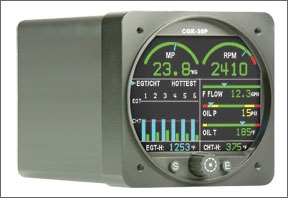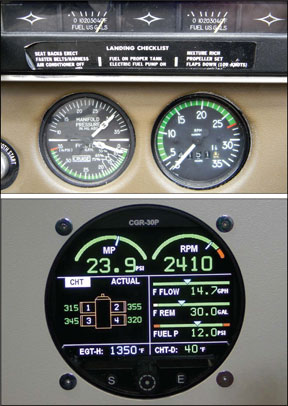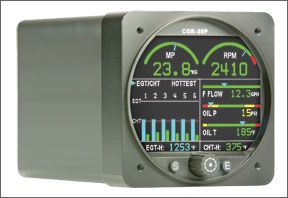Aside from requiring a complex installation, large screen engine monitors eat a lot of panel space. This often means having to relocate instruments and even building a new panel to accommodate the big screen.

Oregon-based Electronics International set out to tame that dragon when they designed the new CGR-30P—a primary monitor that fits a standard 3-inch instrument cutout. The idea here is to remove the existing tachometer (the system is approved to replace it) and use the blank cutout it leaves behind. We looked at the certified CGR-30P at this year’s AirVenture and were impressed by its simple feature set, sharp display and impressive low price.
Chameleon Instrument
That’s what Electronics International calls the CGR-30P because you can customize the data on the screens to show a variety of engine functions. Unlike other systems that display all parameters on a single screen, the CGR uses a total of four screens—much like a multifunction display.
The CGR is mounted from behind the instrument panel and measures 3.25 inches wide, 3.25 inches high and 4.36 inches deep. Unlike other models, the CGR won’t overhang surrounding instruments because it mounts flush to the surface of the instrument panel.
Moreover, CGR stands for cluster gauge replacement because the unit can replace multiple primary instruments under its TSO approval. This includes the tachometer, manifold pressure, fuel flow, fuel quantity and a host of other primary functions. For aircraft with a round engine cluster gauge, the CGR is the perfect form factor for replacing it.
The color display is backlit for night operations and has a good side viewing angle. We didn’t evaluate the unit in direct sunlight, but like most color displays, we suggest mounting the unit as close to eye level as possible.
Main Screen
The unit replaces up to seven primary engine gauges and up to five secondary or non-limited gauges, including all EGTs and CHTs. RPM, EGT and CHT are all default functions, and the user can pick and choose other primary and secondary gauges they wish to add to the product before it ships from the factory.
The main page of the CGR displays engine manifold pressure and RPM, which is displayed side by side in both a numerical and graphical presentation, plus four other configurable primary functions. ECI told us most users select fuel flow as one of the other primary parameters. From there, you can add oil temperature, oil pressure and bus voltage, for example. These functions are approved for replacing primary instruments. For engines that don’t have a manifold pressure gauge, the data field can be customized to display fuel flow, for example.
The lower half of the main page displays EGT and CHT in the familiar bar graph presentation. The CGR borrows some logic from the company’s MVP-50 monitor—showing engine parameters via digital tape sliders or graphically.
There’s a normalized mode for general health monitoring, a lean mode for operating rich or lean of peak, plus an EGT and CHT graphical display. This is a bird’s-eye digital pictorial of the engine with proper orientation of each EGT and CHT channel and includes the temperature of each.
The user can configure the unit to automatically scan each channel, display the hottest channel, or manually select each cylinder EGT or CHT value. You can also display the difference in temperature between the hottest EGT/CHT and the rest of the monitored channels.
The CGR utilizes only three user controls for simplicity. The ‘E’ key backs out of a screen and ultimately takes you back to the primary screen, the ‘S’ key advances through each screen, and the center menu select knob is used for editing and configuring data. Where other engine monitors might increase workload, we think EI did a good job of keeping workload at a minimum, thanks to a straightforward feature set. We also think the data is presented in a logical manner. Despite the compact screen, the data doesn’t seem crowded.
EXPANsion Galore
Think of the secondary screen as an overflow for displaying additional data (the secondary display still shows RPM and manifold pressure). For example, the fourth primary engine parameter is displayed on this page, in addition to five non-primary instruments. You can select bus voltage, outside air temperature, flight timer and so on. This is also where caution warnings are displayed, should any function on the main screen become flagged.

Speaking of caution warnings, the CGR can annunciate a wide variety of alerts from external systems. Any temperature or resistive fuel level input channel on the EDC may be used to monitor the state of a switch, relay or output from a remote device. This output can be used to trigger an onscreen annunciator on the CGR display. This includes warning lights for a canopy latch, baggage door, pitot heat or other systems you want to monitor on the CGR’s main or system screen. The CO Guardian remote-mounted CO detector can be displayed on the screen.
The CGR can be interfaced with the AP-17V LED annunciator panel. The system includes a remote control box that drives various warning lamps. It has a list price of $195—likely cheaper than the labor it might take to install separate lamps on the panel.
If visual warnings aren’t enough, the CGR can interface with the Electronics International AV-17 voice annunciation system. This remote system provides up to 17 verbal warnings through the headphones via the aircraft’s audio panel or intercom.
The AV-14 is a compact control box that’s connected to a panel-mounted remote switch. When a monitored alarm is triggered, the voice annunciator chimes and a female voice announcing phrases such as “check oil pressure.” The AV-14 is compatible with a variety of remote systems, including landing gear, airspeed sensors and gyro vacuum systems, to name a few. The AV-14 is a $285 option and is compatible with most audio panels.
Fuel Computing
We think any fuel computer installation is incomplete without a connection to a GPS navigator. A GPS interface provides point- to-point fuel endurance for active flight plans and direct-to navigation waypoints. The CGR excels at this integration—offering a healthy level of automation on a dedicated GPS data screen. The unit interfaces with most panel GPS systems with serial data.
The CGR-30P is certified for displaying fuel flow plus primary fuel quantity. It can be ordered in a configuration to monitor up to four fuel tanks, including auxiliary tanks.
The unit is smart enough to know which fuel tank you are drawing from and can estimate how much fuel is remaining in each. A graphical onscreen fuel can depicts the total fuel remaining in all tanks.
We’re impressed at the simple and thorough approach the CGR takes when monitoring fuel endurance. For example, on the fuel page you can scroll through fuel flow plus estimated distance/range based on the active flight plan or waypoint that’s in the connected GPS.
Aside from fuel flow, there’s an estimated quantity remaining when you arrive at your destination the fuel required to reach your destination, and the available reserve at the destination. There’s total fuel used for the flight, fuel used since you last refueled and the current fuel economy. While this may seem like rudimentary fuel computer functionality, EI presents the data in a format that’s easy to read at a glance.
An important note about fuel quantity interfacing with this system and any other: Older resistive fuel level senders are known to create inaccuracy that might require replacement or overhaul and calibration. That’s because fuel sensors can become intermittent and change resistance with age.
Further, if the CGR has not been properly calibrated, it will not display accurate fuel levels. The fuel level calibration process can be tedious and will likely require flight testing. The drill is to go flying and perform the calibration with the aircraft in a cruise angle of attack, and then continue testing for accuracy at different angles of attack. We’ve heard from several owners of other systems who struggle with inaccurate fuel level measurements because the installer cut corners during the installation and calibration process. We suggest working with a shop that has experience in this area.
Priced Per Engine
The CGR30-P is fully certified and TSO’d. Since the CGR-30P is so customizable, pricing will vary based on options. The entry-level package for 4-cylinder engines, which includes RPM, EGT, CHT, fuel flow and bus voltage, has a list price of $3596. Add the fuel flow and fuel quantity option, and the price jumps to $4217. The basic 6-cylinder package starts at $4342. The same 6-cylinder system with fuel flow and fuel quantity is $4714.
Based on 25 hours of installation effort (at an average of $100 per hour), total costs could easily come in below $9000. Of course, dealing with fuel senders and other variables can vary the bottom line.
Since the unit shouldn’t require any cutting of the instrument panel or in many cases the relocation of other instruments, we suspect the CGR could save nearly $1000 compared to other units. When we looked at the unit this past July at AirVenture, it was backordered for several months.
EIectronics International still offers the MVP-50. This is a big-screen monitor that has a starting price of $5995 for 4-cylinder engines.
We’ll look at the big-screen engine monitor market in a future issue. Contact Electronics International at www.Buy-Ei.com, 541-318-6060.





